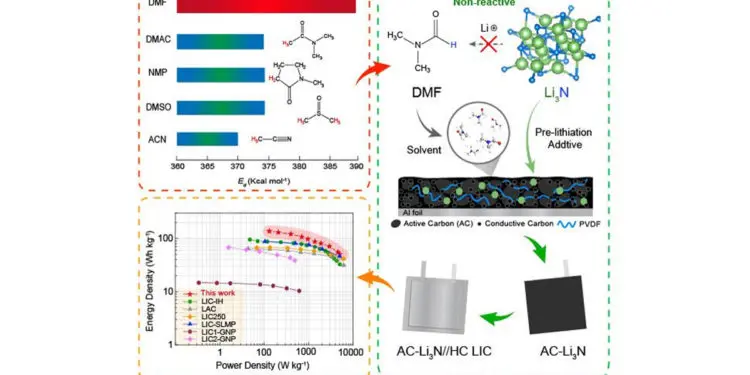Lithium nitride is a well-known positive pre-lithiation additive that can be used to compensate for the irreversible lithium loss that occurs on the negative side during the first charge, thereby increasing the specific energy of the energy storage device. However, in the electrode manufacturing process, lithium nitride would react with the most commonly used solvent, such as N-methyl-2-pyrrolidone (NMP), dimethyl sulfoxide (DMSO), acetonitrile (ACN) and N,N-dimethylacetamide (DMAC). The side reactions make it difficult to manufacture the lithium nitride containing electrode in scale. In this work, it was found that N,N-dimethylformamide (DMF) can be used as a homogenizing solvent to prepare a stable lithium nitride-containing slurry and electrode. Then the problem is solved.
The electrode can realize pre-lithiation of the lithium ion supercapacitor negative electrode, greatly improve the specific energy of the device, and maintain excellent rate performance and cycle stability. The energy retention remains 90% after 10,000 cycles. This technology is expected to find application in other battery systems with low initial efficiency in anode (hard carbon, silicon, etc.)
This work was reported in Science Bulletin, entitled “DMF stabilized Li3N slurry for manufacturing self-prelithiatable lithium-ion capacitor” by Prof. Zhang Hongzhang and Li Xianfeng’s group in Dalian Institute of Chemical Physics, Chinese Academy of Sciences. The researchers studied the common polar solvents and found that the presence of α-H is the main factor affecting the instability of the solvent on the surface of lithium nitride.
###
The research was supported by the National Natural Science Foundation of China (51673199 and 51677176), Youth Innovation Promotion Association of Chinese Academy of Sciences (2015148), Dalian National Laboratory for Clean Energy (DNL180307), Innovation Foundation of Dalian Institute of Chemical Physics, Chinese Academy of Sciences (ZZBS201615 and ZZBS201708), and Dalian Science and Technology Star Program (2016RQ026).
See the article:
Cuilian Liu, Tianyu Li, Hongzhang Zhang, Zihan Song, Chao Qu, Guangjin Hou, Huamin Zhang, Chuanfa Ni, Xianfeng Li. DMF stabilized Li3N slurry for manufacturing self-prelithiatable lithium-ion capacitors. Science Bulletin, 2019, doi: 10.1016/j.scib.2019.11.014































